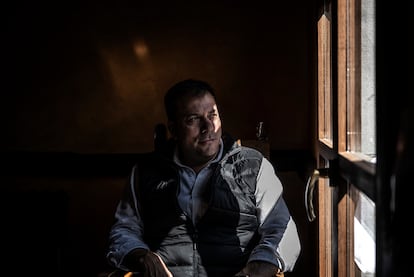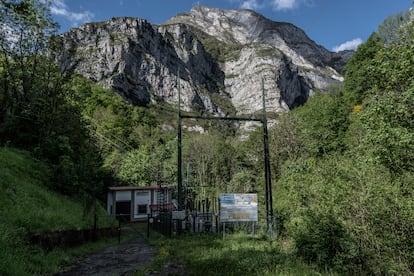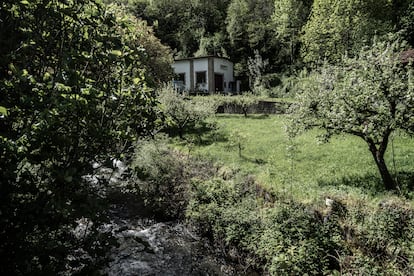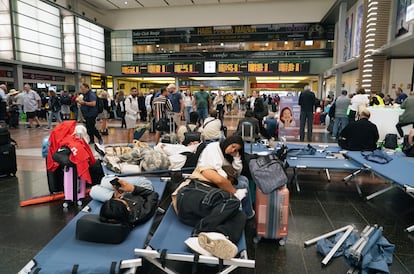A small municipality of the Leonese mountain mocked the blackout | Spain

At 12.33 on Monday, next to the rest of Spain and Portugal, the five villages of the Sajambre Valley They ran out of light. At approximately 12.50, unlike the rest of Spain and Portugal, the 150 inhabitants of this valley, which make up among all a single municipality, had electricity again.
At one thirty, the residents of the surroundings of Doctor Esquerdo Street, in Madrid, queued in the Chinese bazaars to buy pile radios, crossed as the road without traffic lights could and, in the improvised corrillos that had formed in the portals, some sparked blamed all that chaos to the president of Russia, Vladimir Putin. At that same time, most of the residents of this Leon Valley one step away from Asturias encased in one of the most rugged and beautiful areas of the Picos de Europa let the morning run as if nothing happened. In fact, nothing happened there.
Accustomed to these twenty -minute specific lights, very numerous in the area, many did not even find out about the general blackout that hovered beyond their mountains. The baker, Mercedes Alonso, without going any further, busy in the workshop to make muffins and cakes, he knew from the cut of light in the rest of Spain at about six in the afternoon. By then, in the street of Doctor Esquerdo, the anti-Putin corrillos had dissolved, there were no pot to batteries anywhere and the most insight had learned to cross the street without traffic lights.
« That day was the world upside down, » summarized on Wednesday the mayor of the municipality of Oseja de Sajambre, Antonio Jaime Mendoza, of the PP, in the Plenary Hall of the City Council. Because the 150 heroes of this electrical story mocked the historical blackout that melted black to the peninsula, Precisely, to know a lot about supply cuts.
The valley is a paradise isolated from everything. From León it is reached through a dizzy road that culebrea along twenty kilometers along the skirt of the mountain after leaving behind the port of El Pontón. In the surroundings there are wolves, roeans, rebels, otters and wild boars. The villages are surrounded by impressive beech forests, oaks and birch. The river seals the valley in two. It is not entirely unusual to run into a bear that goes down to feed on the people, although at this time of the year they entertain more with the cherries that begin to sprout in the middle part of the mountain. Spring in the region is a blessing from heaven. Winter, on the contrary, is as beautiful as it was hard. The storms, the force of the wind, the temperatures below zero and the snowfall of one meter break the high voltage cables, destroy antennas or put down electric turrets.
Due to this weather, over the years the residents of Oseja de Sajambre have suffered frequent cuts of light that lasted several days and that were difficult to fix because the operators responsible for repairing them had complicated until they reached the place of the breakdown.

The mayor promised years ago to fix the problem. And contacted the companies that run the three hydroelectric mini -stations located in the valley. Because the area, due to its special orography, generates electricity. What happens is that this electricity obtained is completely heading to Asturias and the supply that feeds the valley is the one that comes back. That is why it was enough that one that cable from which electricity brought from Asturias was burst in the middle of a November storm or a snow to leave the valley completely in the dark. And Mendoza simply did not fit in his head that his people produce electricity to export and that, at the same time, winter after winter, they would run out of light.
The solution to which he reached about five years ago with the electric company was as follows: the investment and technical improvements necessary would be carried out so that, in case of light cutting, the valley benefited, thanks to a kind of internal splicing, of the electricity generated by at least one of the hydroelectric stations. « Since then, when there is a cut, one of the employees of the substation links with the people and thus we do not run out of light any more time than necessary to carry out the union: from 20 minutes to half an hour. » The technicians call it an island supply. And that is what happened on fateful Monday. The light cut occurred, although, for once, this was not caused by the special conditions of the valley but by an external fault. The operator in question did not matter to him: he linked the substation with the people as he always did and-he-hop!-Light was made throughout the valley.

To the mayor the general blackout – and the almost automatic electric recovery of his people – caught him in the car, traveling to Oseja from Valladolid. « The assistant technician told me because he is a councilor and he was the first to warned me that we might be the only municipality with Luz throughout Spain. »
Sitting in the plenary hall, remember that day in which the world was the other way around and reflects: « Now, everyone thinks they are always covered, they have the confidence that nothing will never happen. We in the town know that things end up happening, because they have happened to us. Because of that, this time, we have been more prepared than the rest. »

That Monday afternoon, upon arriving at the town, the mayor went to visit his mother. He found her watching television with her sister, the two with more than eighty years, hypnotized to an informative special in which she realized the blackout in the rest of Spain, with images of the subway stations evicted in Madrid and the roads stuck in the big cities. When the two old women heard entering the mayor, they exclaimed, pointing to the screen, like the one who comments on what happens on Mars: « Have you learned, Antonio, what happens outside here? »







